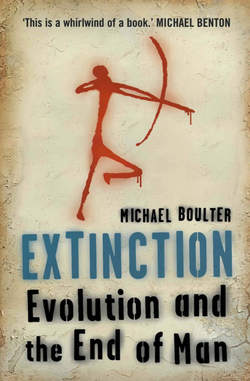Extinction: Evolution and the End of Man

Реклама. ООО «ЛитРес», ИНН: 7719571260.
Оглавление
Michael Boulter. Extinction: Evolution and the End of Man
Extinction
Michael Boulter
Table of Contents
Introduction
1 The Past Is Not Over. Some remnants of Iron Age man
Some remnants of modern man
Journey from the beginning of time
Challenges for a young research group
2 Extinction. Jurassic story
Westward Ho!
The K–T catastrophe
First recoveries
Looking for trends
3 A System out of Chaos. White noise in the universe
Sand piles of self-organisation
Gaia
Unmeasured patterns of beauty
Measuring patterns of evolution
Differing rates of evolution
A decade for databases
A new shape to evolution: exponential change
4 From Dinosaurs to Us. Recovery from Chicxulub
Age of the broadleaf forest
The Atlantic River
Changes in the oceans
Out of the ocean rises Atlantis
Cool rhythms of the Miocene
Towards an icehouse world
From millions of years to tens
5 What’s in a Name?
The building blocks of God’s nature
Darwin leaves town
Against species
Old wine in new bottles
Methods of visualising evolutionary change
Another new model for evolution
6 A Man-Made Extinction Event. Modern humans’ first aggression
No response to climate change
Extinctions in response to humans
Unproven Jears
7 Humans and the Future. Another view of the future
The new idea: self-organised mass extinction from within
Towards human extinction?
A double whammy
New life for the Earth
Notes. CHAPTKR 1
CHAPTER 2
The Dorset coast:
Cretaceous-Tertiary catastrophe:
The P–Tr boundary event:
Further reading:
CHAPTER 3. The Big Bang and early history of Earth:
Sand piles and self-organised systems:
Punctuated equilibria and logistic models:
Mass extinctions:
Gaia:
CHAPTER 4. K–T and the recovery:
Opening of the North Atlantic:
Tertiarv cooling:
Icehouse world:
CHAPTER 5. Species and other taxa:
Ideas on evolution since Darwin:
Bell curves:
CHAPTER 6. Neanderthal man:
Conservation:
Climate change:
CHAPTER 7. Evolutionary psychology:
Mammals and early humans:
Patterns and beauty:
New life from extinctions:
Index
Acknowledgements
About the Author
Copyright
About the Publisher
Отрывок из книги
Evolution and the End of Man
Title Page
.....
Large numbers of these 54o-million-year-old fossils from British Columbia show that an enormous structural diversity was present early in the history of life. Because they are among the first non-microscopic organisms they have many unusual features, hard to find in fossils that lived since, and controversy continues to haunt our interpretations. The remains were discovered in 1909 by the paleontologist Charles Walcott, who explained them as ‘a sublime conception of God which is furnished by science.’ Their different shapes and structures show unusual variety, and many scientists have thought them to be unlike more recent animals that they have seen then representing extinct groups. They also seem to have diversified suddenly and become extinct just as quickly. A more recent approach has been to look at the similarities between the fossils’ characters. Links have been made to familiar groups like trilobites and sponges. The confusions should be no surprise, because most new things start off by looking strange.
Our 65-million-years-to-a-day journey is reaching familiar territory now. Through middle August life is evolving very fast, diversifying day by day – vertebrates, ferns, dinosaurs. Some groups become extinct in those early and mid-August days: trilobites and jawless vertebrates. Then, on 20 August, the dinosaurs become extinct as well. On this time scale, that happened yesterday.
.....